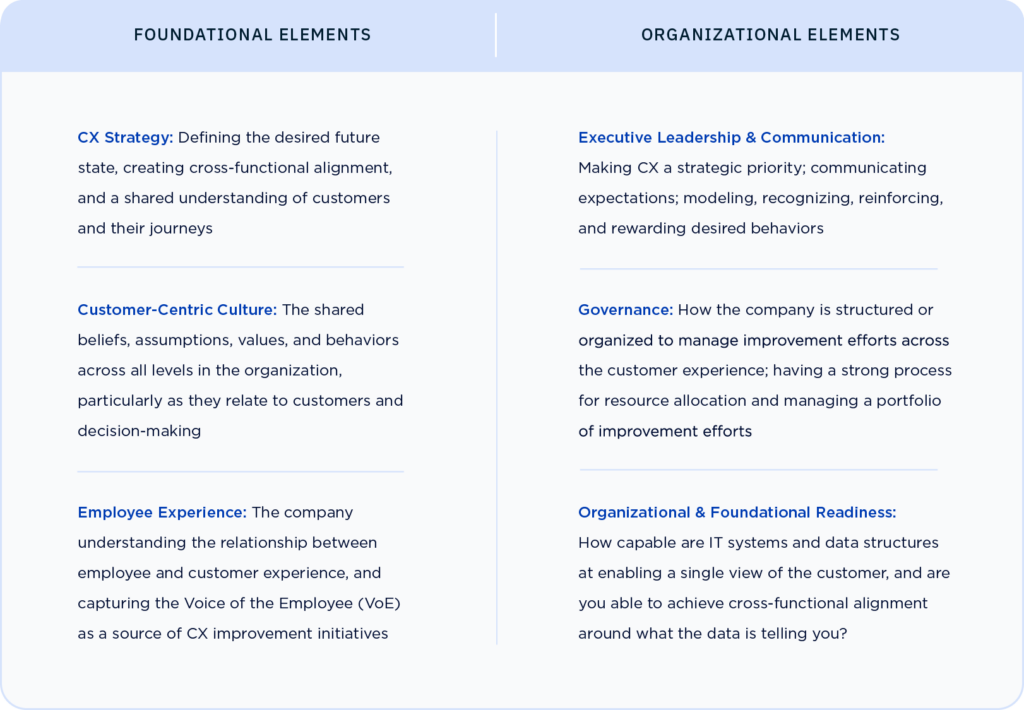The Elements You Need for A Successful CX Program

We’ve evaluated the pros and cons of primary reporting locations for the customer experience (CX) function and ideal CX leader qualities in previous articles, “Where Should CX Live Within An Organization?” and “Does Who’s Driving the CX Bus Make a Difference?”
It’s now time to discuss the organizational elements that are necessary for CX to thrive in an organization (regardless of the reporting structure your organization chooses or the characteristics of the person leading the CX function).
We utilize a continuous improvement framework with our clients that starts with the principle of “design with the end in mind.” This means achieving one or more of the four key economic pillars: acquiring more customers, keeping more customers (reducing churn), growing lifetime customer value (CLV), or reducing cost to serve.
The Five Stages of the Continuous Improvement Framework:
Stage #1: Design
Clearly design an experience strategy that aligns with overall company goals and brand promise, driving customer outcomes.
Stage #2: Listen
Thoughtfully deploy modern listening strategies and data integrations across the journey to expand and enhance an integrated view and holistic customer understanding.
Stage #3: Understand
Consolidate all data streams and leverage advanced analytics to identify where and how to act (and the anticipated impact on customer outcomes).
Stage #4: Transform
Create & implement dynamic action plans, training, and policies that facilitate organizational change (and promote activities that drive customer outcomes).
Stage #5: Realize
Evaluate and demonstrate results of experience initiatives including (but not limited to) organizational change, improved metrics, and financial impact.
Building the Foundation for A Successful CX Program: Moving Beyond the Continuous Improvement Framework
Beyond those five core stages, though, there are certain foundational and organizational elements that must be present for CX to thrive in your company.

What these additional elements suggest is that customer experience is a team sport that requires the participation, alignment, and coordination of the entire organization—and that your success will be limited if it is a grassroots effort and not a strategy led and supported by the executive leadership team. That alignment and shared understanding is vital to CX success, and by extension, the wider success of your entire organization.
Our hope is that this three-part series has given you much to consider about your organization’s customer experience efforts. Based on what we see in the marketplace, too many programs are still stuck in the Listen and Understand stages and have not figured out how to get organized to break down silos in order to drive effective improvement efforts or don’t have the executive leadership and buy-in to facilitate this. Breaking down these silos, both in terms of the organizational design as well as internal data structures, requires executive leadership engagement and strategies to enable a single view of the customer.
Driving ROI from your customer experience efforts continues to be the biggest conversation in the CX community and the greatest challenge for most companies. And your C-Level executives, board and shareholders expect this.
Being organized properly, having the right people with the skill sets that we discussed in place, migrating your culture to one of customer-centricity and getting organizational alignment on what customers need and how to best, and most efficiently, meet these desires is really tough work. But it is critical to have all of these elements in place in order to drive the best CX outcomes. And the companies that can do this are the ones that stand to reap the greatest benefits in terms of future revenue and market share growth and long-term profitability.


